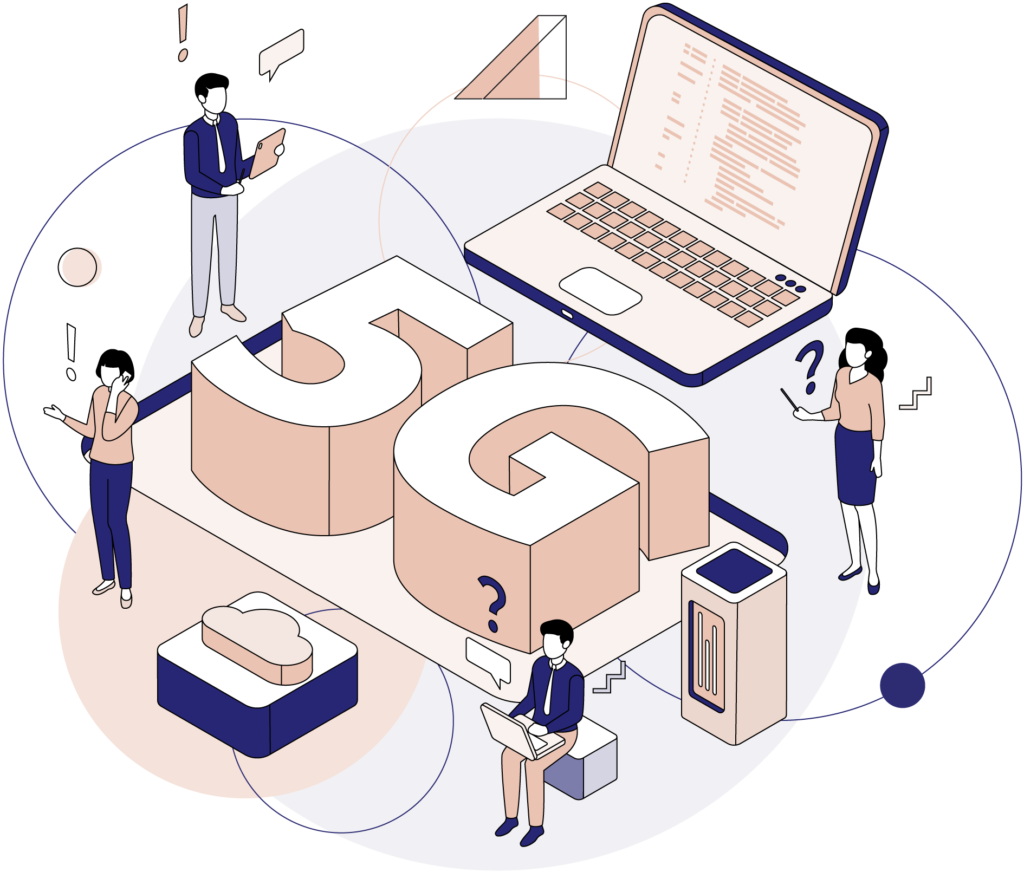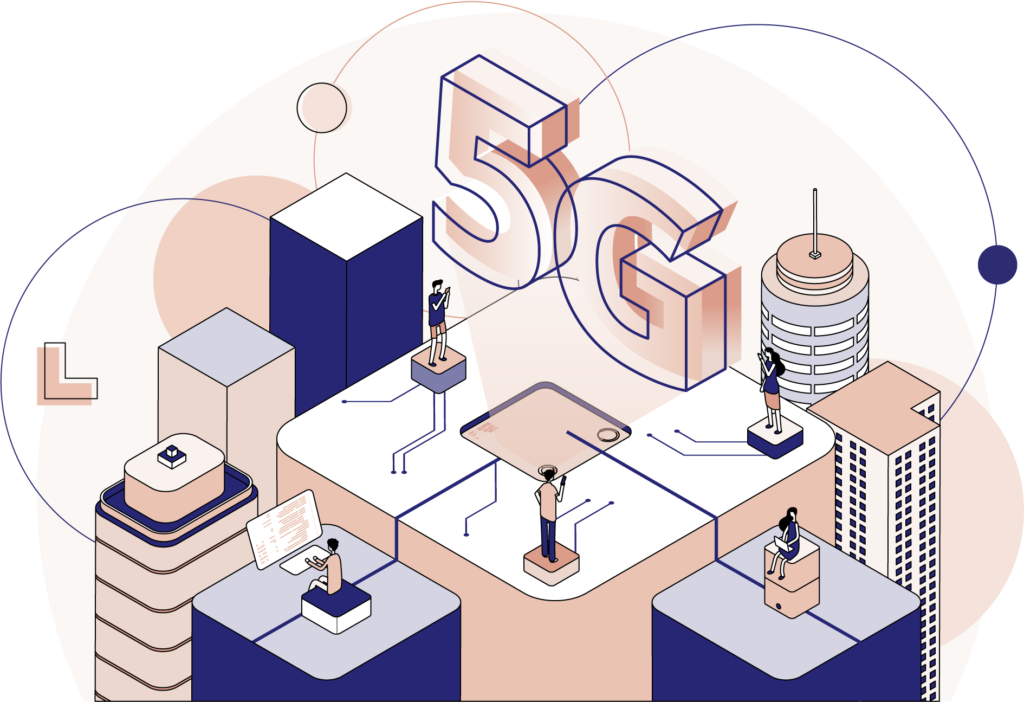Whether for business or personal use, we all demand that that our mobile internet connections are fast, reliable, and have the bandwidth to cope with whatever we need them for; be it streaming, browsing, video calls, or downloading files.
By the end of 2024, global mobile data traffic is expected to grow by more than five times its current levels, with 1.25 billion more people using the internet by 2025. Existing networks will not be able to cope with this volume of traffic, leading to the advent of the fifth generation of network technology, better known as 5G. We explain what 5G is, why it’s causing debate, and weigh up the potential of this technology evolution.
What is 5G?
Wireless technology is not a new phenomenon. The very first iteration of the technology, known as 1G, was first launched in Tokyo in 1979, followed by 2G in 1991. 3G launched ten years later, with 4G close behind in 2009.
| Year | Capability | User Speed | Latency (milliseconds) | Throughout in a cell | |
|---|---|---|---|---|---|
| 1G | 1979 | Mobile voice calls | 2-14 kbps | No data | 2 kbps |
| 2G | 1991 | Mobile voice calls and SMS | 40 kbps | 300-1000 | 64 kbps |
| 3G | 2001 | Mobile web browsing | 256 kbps | 100-500 | 2 mbps |
| 4G | 2009 | Mobile video and enhanced browsing | 10-20 mbps | 20-30 | 100-200 mbps |
| 5G | Now | IoT and industrial digitalization | 1 gbps | <5 | >10gbps |
As well as providing a more stable and secure connection, 5G will be around 100 times faster than existing networks due to its use of shorter frequencies of 30 GHz – 300 GHz millimeter waves. The 5G network response time, known as latency, will be fast enough to download a 4K high-definition movie in just 25 seconds. 5G will bring all these improvements for a cost roughly ten times lower per gigabyte than 4G currently offers.

5G debates
Despite the improvements and market benefits we’ll see from 5G networks, the road towards this global upgrade hasn’t been entirely smooth.
China & 5G
China is currently the world leader in 5G technology. Followed by South Korea, China has the most 5G patent filings, and Asian companies have sold the most 5G smartphones globally. China is investing massively in 5G capabilities, with the country earmarking roughly $170 billion in 5G spending over the next five years.
It’s predicted that the 5G market itself will be worth $5.53 billion in 2020, growing to $6677.9 billion by 2026 with a CAGR of 122.3% throughout 2021-2026. Huawei and ZTE alone account for 40% of global 5G infrastructure. Huawei is also second only to Samsung in smartphone manufacturing, having overtaken Apple in 2019.
Earlier this year, the USA used powers designed to combat the transfer of military technology to stop Chinese-owned telecoms company Huawei from using any USA-produced components in its technologies. These sanctions will soon be extended to non-USA components.
The European Union and the UK are following the USA’s lead on moving away from Chinese 5G manufacturers over fears that Europe is becoming too reliant on Chinese technology; among others, France announced a de facto ban on Huawei 5G equipment in densely populated areas by 2028, and UK telecoms operators are required to stop buying Huawei 5G equipment from the end of 2020. Replacing Huawei and Chinese-owned ZTE’s 5G technology purchased since 2016 is estimated to cost $3.5 billion.
Public perceptions
A UK survey found that less than a quarter (24%) of the British public have a ‘good’ understanding of 5G technology. Just 2% said they were currently on 5G plans, and only 27% intend to adopt 5G in future. Among those who didn’t want 5G, the most common reasons against adoption were that their current technology was sufficient (40%), cost (36%), and device compatibility (33%).
This lack of understanding and apathy over adoption may have helped to fuel misinformation that resulted in attacks on phone masts over claims that 5G had negative health impacts. There are also lawsuits and demonstrations taking place to halt the roll out of 5G, as well as rumors about Russia-sponsored media “linking 5G signals to brain cancer, infertility, autism, heart tumors and Alzheimer’s disease”. Worries over potential harm from radio waves or radiation remain unproven.
Environmental impact
5G networks consume more energy than their predecessors as 5G’s short wave frequency means it has a lower density; 5G needs three times the number of masts as 4G to cover the same area. This may be partially offset by 5G’s power consumption per bit being 90 per cent lower than 4G, but critics point out the increased energy consumption resulting from more connected devices – predicted to be a 1,000 fold increase in the next decade – will negate these gains.
At present, 1.4 billion devices are manufactured every year, and around 9,023 smartphones are thrown away every second. Manufacturing smart devices requires nonrenewable materials: the average smartphone requires 7kg of high-grade gold ore, 1kg of typical copper ore, 750g of typical tungsten ore and 200g of typical nickel ore, all of which must be extracted through mining operations.
5G’s incompatibility with previous generations’ devices will likely increase pressure on this supply chain as consumers are forced to upgrade from devices which still work but are now outdated. 49.8 million tonnes of e-waste is generated per year, and it’s likely 5G will exacerbate this issue. There is, however, a growing movement towards a smart device circular economy, which may become more prominent as 5G enters the mainstream.

The promise of 5G
Many new and innovative technologies that have the potential to revolutionize the world are conditional on 5G deployment. As well as powering a connected world, 5G enables technologies that can save lives, promote wellbeing, reduce carbon footprints, and create a safer world fueled by data-driven decision making.
IoT
The Internet of Things (IoT) has long been touted as the next technological revolution, but IoT is dependent on the low latency and rapid speeds of 5G. Estimates suggest that the next five years will see global IoT connections rise to almost 25 billion, more than doubling today’s figure. IoT revenues will hit $1.1 trillion by 2025.
The IoT will touch almost every area of modern life, from entertainment to agriculture, retail, and manufacturing. Smart factories, telemedicine, and AR/VR, for example, all require the speed and bandwidth 5G offers if they are to experience mass adoption and for improvements to be made to their existing capabilities.
Autonomous driving is just one world-changing innovation made possible by 5G and the IoT. Predicted to be worth $556.67 billion by 2026, autonomous driving alone will power evolutions in other industries such as haulage and transport, as well as shaking up supply chains and redefining consumer relationships with personal vehicles.
Autonomous vehicles can help to reduce congestion, accidents, and emissions through optimized driving and the reduction of human error. The technology can also democratize mobility for elderly or disabled people. Sensors embedded within connected vehicles can also feedback real-time data on everything from road conditions to the density of pedestrians, facilitating vastly improved city planning as well as optimized incident response times and proactive risk management.
Safety & wellbeing
The ‘smart city’ concept will become a reality as 5G rolls out, delivering improvements such as intelligent lighting, waste management, smart parking, water metering, and environmental monitoring.
US cities provide numerous examples of 5G’s power to improve a population’s wellbeing through smart-city technology. San Diego, California, has already saved almost $2 million and cut energy waste by adopting smart lighting systems which dim when not required, and streetlights with air quality sensors are being installed in Pittsburgh, Pennsylvania. In in neighborhoods suffering from high crime rates in San Francisco, California, gunshot-detecting microphones have been installed to enable faster incident response. South Bend, Indiana, has installed waterflow redirection technology to avoid floods when sewer levels are under pressure.
5G will also improve critical services in the safety and healthcare arenas. At-risk patients can access wearable or implanted medical devices monitoring vital signs and allowing detection of early warning signals for life-threatening conditions such as heart attack or strokes, reducing fatalities. Personalized treatment plans can be developed based on the extensive monitoring and analysis 5G will open up to healthcare providers.
Emergency personnel will benefit from 5G as drone and real-time data monitoring technology improves, and the potential for robotically assisted remote surgery opens cutting-edge healthcare to regions and communities across the world. 5G-powered remote surgery has already proven possible and could help to reduce waiting times for patients, as well as reducing the stress an aging population will put on healthcare systems around the world.
Business
Research from the World Economic Forum (WEF) concludes that 5G will bring “significant economic and social value” such as “enabling sustainable cities and communities.” The WEF’s 5G Impact Report emphasizes the importance of businesses operating with communities in mind, which will bring additional benefits in terms of both infrastructure and cooperation.
“The private sector’s prioritization of social value creation when designing business models may not only maximize the benefits to society but may potentially strengthen the business case for 5G deployment by, for example, attracting sustainability driven investments or better aligning with government agendas that prioritize GDP growth, job creation or climate change solutions.”
Businesses themselves will experience 5G benefits across their entire ecosystems, from recruitment to production and supply chains. Consumer goods giant Unilever, for example, found multiple benefits from using 5G-powered machine learning technology in a test recruitment process, resulting in a 100% increase in hire yield, a 75% reduction in time to hire, and a 25% decrease in recruitment costs.
By 2035 it’s predicted that 5G will underpin around $12.3 trillion worth of goods and services across almost every industry, and so investing in 5G innovation will open companies to a host of opportunities. Research shows that 82% of business leaders expect small business growth and more competition as a result of 5G, and 85% expect it to make companies more competitive on a global scale. Be it a retail firm investing in AR/VR or a manufacturer upgrading to the latest digital twin capabilities, staying ahead of the competition will be key for all kinds of businesses in this next-generation market environment.
Importantly, we have yet to see the full potential of 5G. As with previous generations, many new apps, innovations, and technologies not yet realized will become possible as 5G’s true capabilities are tested and expanded by innovators and entrepreneurs across the world. The promise of new and exciting innovations powered by 5G technology opens up a world of possibility for businesses and consumers alike.
Amaris Consulting’s capabilities in Telecom provides a 360 approach to telecommunications technologies. We support our clients throughout every stage of their journey and have Centers of Excellence across the world dedicated to fibre optics and wireless projects. We help our clients to design, shape, install, and operate their next generation network infrastructure to maximize opportunities as well as ensure success.
For more information on Amaris Consulting’s Telecom capabilities, visit amaris.com.


